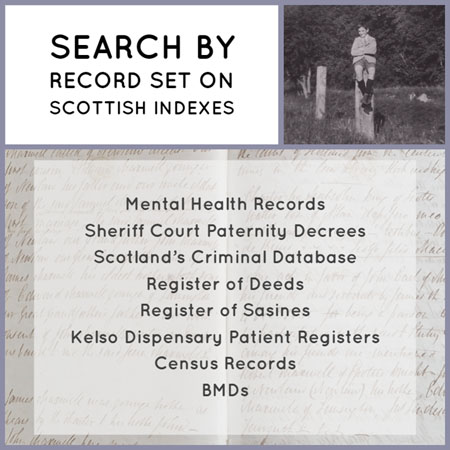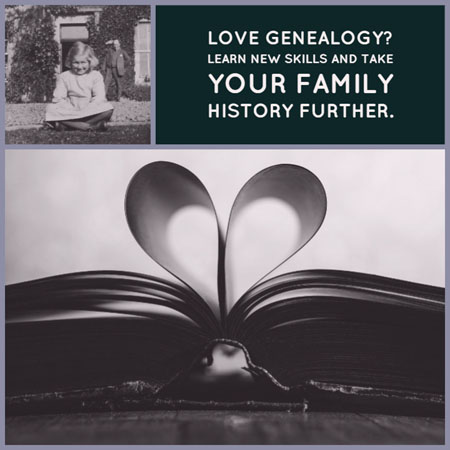Learning Zone - Use of Maiden Surnames in Scotland
Maiden Surnames in Census Records
Maiden Surnames in Birth, Marriage and Death Records
Maiden Surnames in Church Records (OPRs)
Maiden Surnames in Court and Legal Records
Maiden Surnames in ‘Lunatic’ Asylum Patient Records
Searching our Historical Indexes
Quick Facts
It is perfectly legal for a woman in Scotland to continue to use her maiden surname or use her husband's surname. In the past, many women would use both surnames but this is not very practical in the modern world.
It was not normally a tradition for Scottish women to use their maiden surname as a middle name after marriage. Use of double barrelled surnames to incorporate the maiden surname is rare.
When two surnames are given, the first surname is the woman’s maiden surname then we generally see ‘or’ and then her married surname is given. This can be confusing as the word ‘née’, from French meaning born, is used after a woman’s married name to introduce a woman’s maiden surname. Although née is now used in Scotland, this is not an old custom so if you are tracing your Scottish family tree you are unlikely to see this in Scottish records before 1900.
Here is an example of of the Scottish custom, Jean McTavish or McAlpine. This is a very standard entry found in the ‘General Register of Lunatics in Asylums’, dated 1858. McTavish was Jean's maiden name, McAlpine was her husband's name. We see women’s names in this format in many records and this can be very useful when we are researching our Scottish ancestors.
Read more about Scottish Mental Health Records here in our Learning Zone.
Maiden Surnames in Census Records
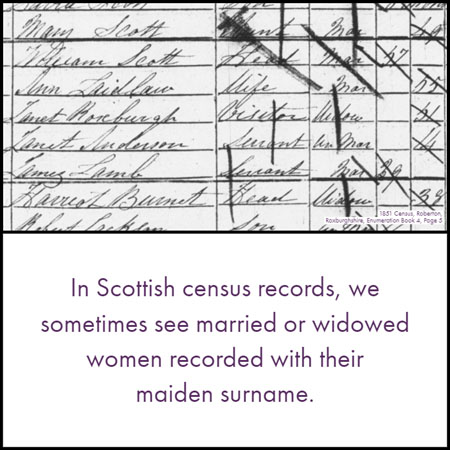
The use of maiden surnames in Scottish census records vary. The schedule was completed either by the head of the household (or the enumerator, if the head of household could not do this). Then the enumerator would copy the information from the schedule into the census enumeration books we see today. As many enumerators would copy the information very faithfully from the original schedules, the preference of the individual as to how a family was recorded would be preserved. In other cases, the enumerator might convert the surnames of women with maiden surnames into married surnames.
The 1851 census records for the Parish of Roberton, Roxburghshire, Scotland records many maiden surnames of married women. Here we see William Scott recorded with his wife 'Ann Laidlaw'. In this case, Ann is recorded as married to William but her surname is given as Laidlaw, not Scott. This can be really useful when you are tracing your Scottish heritage.
See our index to the Roberton 1851 census here.
This practice is really useful because we can discover an ancestor’s maiden surname really easily, but it can make them a bit tricky to find because we may be looking under the wrong surname.
In another example we see a widow Harriot Burnet recorded with her maiden surname. Harriot may be particularly difficult to find as she is obviously not with her husband.
Top Tip: If you are looking for a married or widowed female ancestor in the Scottish census and you cannot find her search using her maiden name.
Maiden Surnames in Birth, Marriage and Death Records
We generally use church records to trace our ancestors' births, marriage and deaths before 1855. There was no standard form for church registers in Scotland and each parish clerk recorded these events in different ways. Some clerks used a register and made their own form, others kept the records in a notebook or account book.
Sometimes what we are looking at is not a record of a death but a record of the family hiring the mort-cloth for the funeral. Or we may be looking at the recorde of an engaged couple paying to have the marriage banns read out at church. The registers vary in style and woman are recorded in various ways in these registers.
A Scottish death register entry may say something like, “Widow Allen”, this would indicate that the lady was the widow of Mr Allen. Alternatively, we see may see “Margaret Anderson, wife of James Scott”, this is useful as we see the woman’s maiden surname and who she married.
A birth register can have a variety of formats. Sometimes we see: “Ann, daughter of James Scott and Mary Anderson”. With modern eyes, we may presume that James and Mary were not married but this is not the case, it is simply that Mary is being referred to with her maiden surname. If the couple were not married that would be made clear, the word ‘natural’ would be used, “Ann, natural daughter of James Scott and Mary Anderson”, or it might more bluntly be put, “born in fornication”.
Birth registers may also say, “Ann, lawful daughter of James Scott and Mary Anderson”, in this case ‘lawful’ means that the couple were married.
Many women who married had not been married before, but if they had been the entry would usually still be recorded using her maiden surname. In England and other countries, widowed women would still use their husband's name and we would look for a second marriage under that name, this was not the custom in Scotland. If you are looking for a widow marrying again, look under her maiden surname.
Find out more about Births, Marriages and Deaths in Scotland before 1855.
Maiden Surnames in Church Records (OPRs)
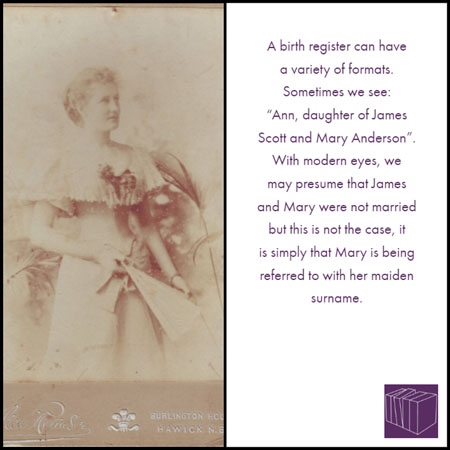
We generally use church records to trace our ancestors' births, marriage and deaths before 1855. There was no standard form for church registers in Scotland and each parish clerk recorded these events in different ways. Some clerks used a register and made their own form, others kept the records in a notebook or account book.
Sometimes what we are looking at is not a record of a death but a record of the family hiring the mort-cloth for the funeral. Or we may be looking at the recorde of an engaged couple paying to have the marriage banns read out at church. The registers vary in style and woman are recorded in various ways in these registers.
A Scottish death register entry may say something like, “Widow Allen”, this would indicate that the lady was the widow of Mr Allen. Alternatively, we see may see “Margaret Anderson, wife of James Scott”, this is useful as we see the woman’s maiden surname and who she married.
A birth register can have a variety of formats. Sometimes we see: “Ann, daughter of James Scott and Mary Anderson”. With modern eyes, we may presume that James and Mary were not married but this is not the case, it is simply that Mary is being referred to with her maiden surname. If the couple were not married that would be made clear, the word ‘natural’ would be used, “Ann, natural daughter of James Scott and Mary Anderson”, or it might more bluntly be put, “born in fornication”.
Birth registers may also say, “Ann, lawful daughter of James Scott and Mary Anderson”, in this case ‘lawful’ means that the couple were married.
Many women who married had not been married before, but if they had been the entry would usually still be recorded using her maiden surname. In England and other countries, widowed women would still use their husband's name and we would look for a second marriage under that name, this was not the custom in Scotland. If you are looking for a widow marrying again, look under her maiden surname.
Find out more about Births, Marriages and Deaths in Scotland before 1855.
Maiden Surnames in Court and Legal Records
The two most common types of legal documents we use when tracing our Scottish ancestors are Wills/Testaments and Sheriff Court Affiliation and Aliment (paternity) records. In both of these record types, in common with other legal records, such as deeds and sasines, married women were almost always recorded with both their maiden and married surnames, apart from some early records where the maiden surname only may be given.
Most women who had illegitimate children were single, but some were married and brought their case to court as married women. Here is an example of "Agnes Scott, spouse of George Graham, Chapelknowe, Half Morton". Notice that the designation of Agnes in this record is "Agnes Scott, spouse of George Graham", her name is not given as Agnes Scott Graham as that is not the custom in Scotland.
We may also see an entry in the format, "Annie Brown or Smith, wife of James Smith (Grocer), Glasgow" so we have to be prepared for a bit of variation.
In the case of criminal records things can be a little more confusing. As well as women who had a married and maiden surname we see ‘aliases’ and people using alternative names to hide from the law! If you see an alternative name in these records you may not be able to presume that it is a maiden name, be cautious and do some more research.
To confuse matters a little further, a child who was illegitimate may use both their father's surname or their mother's surname. This means that we can at times see a single woman with two surnames. When we see an entry with 'or' we need to dig a little to make sure we know what that means in our case.
Maiden Surnames in ‘Lunatic’ Asylum Patient Records
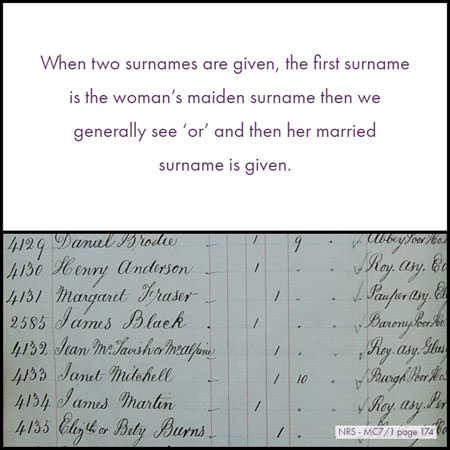
In the ‘General Register of Lunatics in Asylums’ married women are almost always recorded as 'maiden name or married name', which is a great way to be able to make sure you have the right person. Occasionally, though, the ‘or’ has been omitted in the register, so beware of this!
In October 1858 we see Mary Barrowman or Gemmell admitted to Langdale House, Bothwell. Mary was the wife of John Gemmell, and having two surnames will help us pinpoint our ancestor!
When you search our index to Scottish Asylum records women are indexed under both married and maiden surnames (when given). Our hope is that you can use this feature to find the person you are looking for.
Our Search Scottish Asylum Patient Records on Scottish Indexes.
Searching our Historical Indexes
Wherever possible we have included both a woman's married and maiden surname. This means you should not have to make two searches in most instances.
When you search for Magdaline Scott in the 1851 census, for example, you will see the entry for 'Magdaline Brown' appear in the search results. This is because Magdaline Brown is married to Walter Scott but has been recorded as Magdaline Brown, rather than Magdaline Scott.
If you can’t find the record you are looking for on our website or another, switch to a woman’s maiden surname and see what you find.

